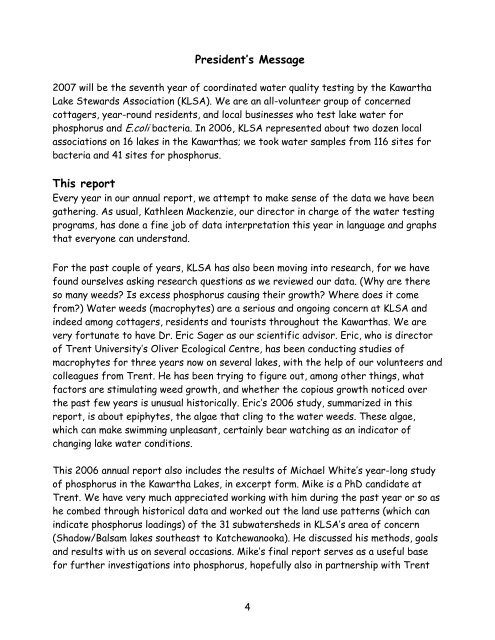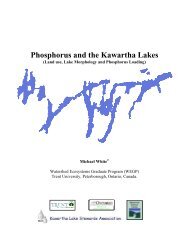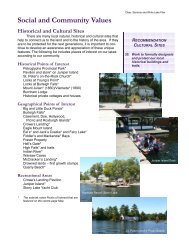Lake Water Quality 2006 Report - Lakefield Herald
Lake Water Quality 2006 Report - Lakefield Herald
Lake Water Quality 2006 Report - Lakefield Herald
Create successful ePaper yourself
Turn your PDF publications into a flip-book with our unique Google optimized e-Paper software.
President’s Message2007 will be the seventh year of coordinated water quality testing by the Kawartha<strong>Lake</strong> Stewards Association (KLSA). We are an all-volunteer group of concernedcottagers, year-round residents, and local businesses who test lake water forphosphorus and E.coli bacteria. In <strong>2006</strong>, KLSA represented about two dozen localassociations on 16 lakes in the Kawarthas; we took water samples from 116 sites forbacteria and 41 sites for phosphorus.This reportEvery year in our annual report, we attempt to make sense of the data we have beengathering. As usual, Kathleen Mackenzie, our director in charge of the water testingprograms, has done a fine job of data interpretation this year in language and graphsthat everyone can understand.For the past couple of years, KLSA has also been moving into research, for we havefound ourselves asking research questions as we reviewed our data. (Why are thereso many weeds? Is excess phosphorus causing their growth? Where does it comefrom?) <strong>Water</strong> weeds (macrophytes) are a serious and ongoing concern at KLSA andindeed among cottagers, residents and tourists throughout the Kawarthas. We arevery fortunate to have Dr. Eric Sager as our scientific advisor. Eric, who is directorof Trent University’s Oliver Ecological Centre, has been conducting studies ofmacrophytes for three years now on several lakes, with the help of our volunteers andcolleagues from Trent. He has been trying to figure out, among other things, whatfactors are stimulating weed growth, and whether the copious growth noticed overthe past few years is unusual historically. Eric’s <strong>2006</strong> study, summarized in thisreport, is about epiphytes, the algae that cling to the water weeds. These algae,which can make swimming unpleasant, certainly bear watching as an indicator ofchanging lake water conditions.This <strong>2006</strong> annual report also includes the results of Michael White’s year-long studyof phosphorus in the Kawartha <strong>Lake</strong>s, in excerpt form. Mike is a PhD candidate atTrent. We have very much appreciated working with him during the past year or so ashe combed through historical data and worked out the land use patterns (which canindicate phosphorus loadings) of the 31 subwatersheds in KLSA’s area of concern(Shadow/Balsam lakes southeast to Katchewanooka). He discussed his methods, goalsand results with us on several occasions. Mike’s final report serves as a useful basefor further investigations into phosphorus, hopefully also in partnership with Trent4





